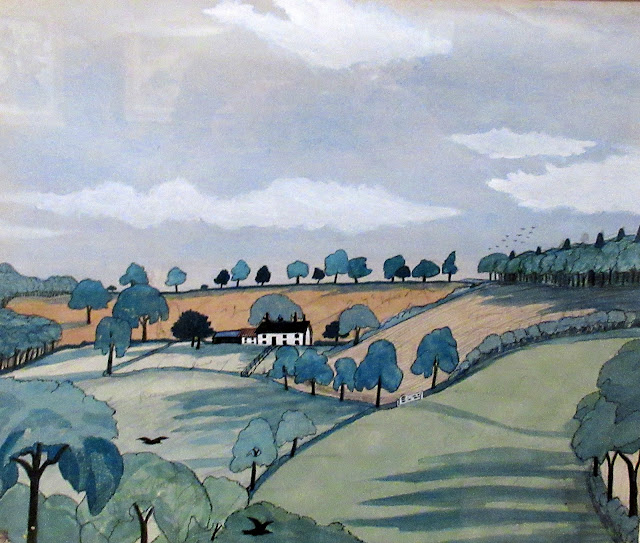John Nash - The Landscape of Love and Solace
at Compton Verney
John Nash (1893-1977) became an artist almost by accident, and once committed to the path, emerged almost fully-fledged onto the London art scene in 1913. Despite being largely self-taught, he went on to earn his living as an artist for over six decades.
His life was one marked by trauma and periodic depression, but also one in which a passionate engagement with landscape and growing things was a source of solace. He married Christine Kuhlenthal in 1916 and for sixty years they shared a love of rural life, an affection for close friends and a distrust of metropolitan pretension.
A painter of oils and watercolour, Nash was also a prolific illustrator, a lithographer and a leading wood engraver. An Official War Artist in both world wars he was a comic artist of wit, an occasional commercial artist and a botanical artist of knowledge and distintion.
In 1967 the Royal Academy held a large-scale retrospective of Nash's work, unprecedented at the time for a living artist. Since then, Nash's oeuvre, centred on observation of landscape and scrutiny of the natural world, has been relatively unsung. This exhibition aims to redress this.
A Bombing Post in the Snow, 1018, (watercolour, chalk and ink on paper)
This drawing, probably the first work Nash finished as an Official War Artist, recreates a situation he described in his last letter to his wie from France, written on the morning of Christmas Eve 1917: 'I spent last night with three of my men in an advanced post - a perfectly uncovered shell hole... there is a chance of being in the front line tonight and for Xmas Day ... we are 700 yards in advance of our Coy... Coming out we passed a Boche officer dead on the road, frozen over and sparkling... nothing unusual for we were just as crystallised, only living - I heard partridges chirping early this morning between crackling burst of machine gun fire'.
This cutting was a reserve line within enemy artillery range where Nash laboured at railway construction for three weeks in March 1916. He later recalled: 'there was an awful lot of humpint stuff down from the top' but in the painting he reverses this, showing human beasts of burden, carrying corrugated sheets up the steep incline, while their comrades march in single file towards the battle front. Their joint activity embraces two aspects of the soldier's lot: primitive labour and the inevitability of going up the line. Nash left the cutting just before the start of the second Battle of Arras, which would claim 380,000 lives.

Over the Top: 1st Artists' Rifles at Marcoing, 1918, (oil on canvas)
In this work of pitiless realism Nash created a testament to the fate of common soldiers in war and a deeply felt personal homage to the men he had known. With its restrained range of malevolent colouring, every element of its design reinforces the sense of unfolding tragedy. Originally focussed on fourteen figures - the number in the section he led as a Corporal that morning, Nash later included an additional casualty in the top left of the fial version; a Sergeant who carries a Lewis Gun behind a fellow Corporal, also a friend, who crumples on his haunches as bullets enter his body. In the eighties Nash recalled: 'It was in fact pure bloody murder... the vivid memory of the occasion provoked whatever intensity may be found in it'.
An infantry column advancing down an avenue of poplars at night. This work carried the message that in the darkness and misery of war individuals can barely be distinguished from the mass.
Known as an artist who 'keeps on the Naturalistic side of abstract principles', Nash nevertheless hovers close to abstraction here. With a deep perspective pulling the eye towards a central vanishing point, a lattice of branches impinging on all sides and an ambiguous massing of trees and shadows, he captures the specifics of a very particular location.
After barely two decades of peace, Nash was horrified by the prospect of a return to war and ambivalent about becoming a war artist once again. He accepted an initial six-month appointment attached to the Navy under the War Artists Scheme, but from the first he was uncomfortable with his role as a spectator. By winter 1940 he was campaigning to get an active service role. He joined the Camouflage Directorate, working in Scotland in 1941-43, and then moving to Portsmouth where he organised decoy and deception preparations prior to D-Day.
In 1918 Nash's war art sprung from the bitter well of his own experience, but in 1940, with one exception, his work suggests a sense of detachment. His service years then saw a long pause in his artistic activity and it was not until after D-Day, about to move to a new home in Wormingford, that he turned to his brushes, pens and pencils once again.
Late Summer, Stoke by Nayland, 1951






























No comments:
Post a Comment